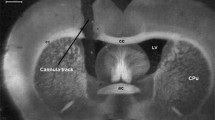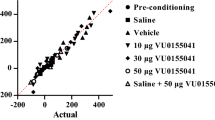Abstract
Some data suggest that morphine induces apoptosis in neurons, while other evidences show that morphine could have protective effects against cell death. In this study, we suggested that there is a parallel role of morphine in reward circuitry and apoptosis processing. Therefore, we investigated the effect of morphine on modifications of apoptotic factors in the ventral tegmental area (VTA) and hippocampus (HPC) which are involved in the reward circuitry after the acquisition and extinction periods of conditioned place preference (CPP). In behavioral experiments, different doses of morphine (0.5, 5, and 10 mg/kg) and saline were examined in the CPP paradigm. Conditioning score and locomotor activity were recorded by Ethovision software after acquisition on the post-conditioning day, and days 4 and 8 of extinction periods. In order to investigate the molecular mechanisms in each group, we then dissected the brains and measured the expression of apoptotic factors in the VTA and HPC by western blotting analysis. All of the morphine-treated groups showed an increase of apoptotic factors in these regions during acquisition but not in extinction period. In the HPC, morphine significantly increased the ratio of Bax/Bcl-2, caspases-3, and PARP by the lowest dose (0.5 mg/kg), but, in the VTA, a considerable increase was seen in the dose of 5 mg/kg; promotion of apoptotic factors in the HPC and VTA insinuates that morphine can affect the molecular mechanisms that interfere with apoptosis through different receptors. Our findings suggest that a specific opioid receptor involves in modification of apoptotic factors expression in these areas. It seems that the reduction of cell death in response to high dose of morphine in the VTA and HPC may be due to activation of low affinity opioid receptors which are involved in neuroprotective features of morphine.







Similar content being viewed by others
References
Adams JM, Cory S (2007) Bcl-2-regulated apoptosis: mechanism and therapeutic potential. Curr Opin Immunol 19:488–496
Aicher SA, Mitchell JL, Mendelowitz D (2002) Distribution of mu-opioid receptors in rat visceral premotor neurons. Neuroscience 115:851–860
Alexander M, Daniel T, Chaudry IH (2005) Opiate analgesics contribute to the development of post injury immunosuppression. J Surg Res 129:161–168
Atici S, Cinel L, Cinel I et al (2004) Opioid neurotoxicity: comparison of morphine and tramadol in an experimental rat model. Int J Neurosci 114:1001–1011
Bajic D, Commons KG, Soriano SG (2013) Morphine-enhanced apoptosis in selective brain regions of neonatal rats. Int J Dev Neurosci 31:258–266
Bals-Kubik R, Ableitner A, Herz A et al (1993) Neuroanatomical sites mediating the motivational effects of opioids as mapped by the conditioned place preference paradigm in rats. J Pharmacol Exp Ther 264:489–495
Billa SK, Sinha N, Rudrabhatla SR et al (2009) Extinction of morphine-dependent conditioned behavior is associated with increased phosphorylation of the GluR1 subunit of AMPA receptors at hippocampal synapses. Eur J Neurosci 29:55–64
Boronat MA, Garcia-Fuster MJ, Garcia-Sevilla JA et al (2001) Chronic morphine induces up-regulation of the pro-apoptotic Fas receptor and down-regulation of the anti-apoptotic Bcl-2 oncoprotein in rat brain. Br J Pharmacol 134:1263–1270
Bradford MM (1976) A rapid and sensitive method for the quantitation of microgram quantities of protein utilizing the principle of protein-dye binding. Anal Biochem 72:248–254
Bryant L, Doyle T, Chen Z et al (2009) Spinal ceramide and neuronal apoptosis in morphine antinociceptive tolerance. Neurosci Lett 463:49–53
Chauveau F, Pierard C, Tronche C et al (2009) The hippocampus and prefrontal cortex are differentially involved in serial memory retrieval in non-stress and stress conditions. Neurobiol Learn Mem 91:447–455
Chen Q, Cui J, Zhang Y et al (2008) Prolonged morphine application modulates Bax and Hsp70 levels in primary rat neurons. Neurosci Lett 441:311–314
Ding YQ, Kaneko T, Nomura S et al (1996) Immunohistochemical localization of mu-opioid receptors in the central nervous system of the rat. J Comp Neurol 367:375–402
Garcia-Fuster MJ, Ramos-Miguel A, Miralles A et al (2008) Opioid receptor agonists enhance the phosphorylation state of Fas-associated death domain (FADD) protein in the rat brain: functional interactions with casein kinase Ialpha, Galpha(i) proteins, and ERK1/2 signaling. Neuropharmacology 55:886–899
Gholami A, Haeri-Rohani A, Sahraie H et al (2002) Nitric oxide mediation of morphine-induced place preference in the nucleus accumbens of rat. Eur J Pharmacol 449:269–277
Gralow I (2002) Cancer pain: an update of pharmacological approaches in pain therapy. Curr Opin Anaesthesiol 15:555–561
Gupta K, Kshirsagar S, Chang L et al (2002) Morphine stimulates angiogenesis by activating proangiogenic and survivalpromoting signaling and promotes breast tumor growth. Cancer Res 62:4491–4498
Haghparast A, Taslimi Z, Ramin M et al (2011) Changes in phosphorylation of CREB, ERK, and c-fos induction in rat ventral tegmental area, hippocampus and prefrontal cortex after conditioned place preference induced by chemical stimulation of lateral hypothalamus. Behav Brain Res 220:112–118
Hochenbery D, Nuna EZG, Milliman C et al (1990) Bcl-2 is an inner mitochondrial membrane protein that blocks programmed cell death. Nature 348:334–336
Hsiao PN, Chang MC, Cheng WF et al (2009) Morphine induces apoptosis of human endothelial cells through nitric oxide and reactive oxygen species pathways. Toxicology 256:83–91
Huppertz B, Frank HG, Kaufmann P (1999) The apoptosis cascade—morphological and immunohistochemical methods for its visualization. Anat Embryol 200:1–18
Ishikawa M, Tanno K, Kamo A et al (1993) Enhancement of tumor growth by morphine and its possible mechanism in mice. Biol Pharm Bull 16:762–766
Kim MS, Cheong Y, So HS et al (2001) Protective effects of morphine in peroxynitrite-induced apoptosis of primary rat neonatal astrocytes: potential involvement of G protein and phosphatidylinositol 3-kinase (PI3 kinase). Biochem Pharmacol 61:779–786
Kinloch RA, Treherne JM, Furness LM et al (1999) The pharmacology of apoptosis. Trends Pharmacol Sci 20:35–42
Koob GF (1992) Drugs of abuse: anatomy, pharmacology and function of reward path-ways. Trends Pharmacol Sci 13:177–184
Le Merrer J, Becker JA, Befort K et al (2009) Reward processing by the opioid system in the brain. Physiol Rev 89:1379–1412
Liu LW, Lu J, Wang XH et al (2013) Neuronal apoptosis in morphine addiction and its molecular mechanism. Int J Clin Exp Med 6:540–545
Mao J, Sung B, Ji RR et al (2002) Neuronal apoptosis associated with morphine tolerance: evidence for an opioid-induced neurotoxic mechanism. J Neurosci 22:7650–7661
McBride WJ, Murphy JM, Ikemoto S (1999) Localization of brain reinforcement mechanisms: intracranial self-administration and intracranial place-conditioning studies. Behav Brain Res 101:129–152
Meriney SD, Gray DP (2001) Morphine induced delay of normal cell death in the avian ciliary ganglion. Science 228:1451–1453
Moaddab M, Haghparast A, Hassanpour-Ezatti M (2009) Effects of reversible inactivation of the ventral tegmental area on the acquisition and expression of morphine-induced conditioned place preference in the rat. Behav Brain Res 198:466–471
Moon TD (1988) The effect of opiates upon prostatic carcinoma cell growth. Biochem Biophys Res Commun 153:722–727
Oliveira MT, Rego AC, Morgadinho MT et al (2002) Toxic effects of opioid and stimulant drugs on undifferentiated PC12 cells. Ann N Y Acad Sci 965:487–496
Olmstead MC, Franklin KB (1997a) The development of a conditioned place preference to morphine: effects of lesions of various CNS sites. Behav Neurosci 111:1313–1323
Olmstead MC, Franklin KB (1997b) The development of a conditioned place preference to morphine: effects of microinjections into various CNS sites. Behav Neurosci 111:1324–1334
Paxinos G, Watson C (2007) The rat brain in stereotaxic coordinates, 5th edn. Academic Press, San Diego
Phillips AG, LePiane FG (1980) Reinforcing effects of morphine microinjection into the ventral tegmental area. Pharmacol Biochem Behav 12:965–968
Rezayof A, Nazari-Serenjeh F, Zarrindast MR et al (2007) Morphine-induced place preference: involvement of cholinergic receptors of the ventral tegmental area. Eur J Pharmacol 562:92–102
Robinson TE, Berridge KC (2003) Addiction. Annu Rev Psychol 54:25–53
Sahraei H, Amiri YA, Haeri-Rohani A et al (2005) Different effects of GABAergic receptors located in the ventral tegmental area on the expression of morphine-induced conditioned place preference in rat. Eur J Pharmacol 524:95–101
Samandari R, Chizari A, Hassanpour R et al (2013) Streptozotocin-induced diabetes affects the development and maintenance of morphine reward in rats. Neurosci Lett 543:90–94
Sastry PS, Rao KS (2000) Apoptosis and the nervous system. J Neurochem 74:1–20
Siegel GJ, Chauhan NB (2000) Neurotrophic factors in Alzheimer’s and Parkinson’s disease brain. Brain Res Rev 33:199–227
Simon EJ (1991) Opioid receptors and endogenous opioid peptides. Med Res Rev 11:357–374
Singhal PC, Reddy K, Franki N et al (1997) Morphine induces splenocyte apoptosis and enhanced mRNA expression of cathepsin-B. Inflammation 21:609–617
Singhal PC, Kapasi AA, Reddy K et al (1999) Morphine promotes apoptosis in Jurkat cells. J Leukoc Biol 66:650–658
Sklair-Tavron L, Shi WX, Lane SB et al (1996) Chronic morphine induces visible changes in the morphology of mesolimbic dopamine neurons. Proc Natl Acad Sci USA 93:11202–11207
Steffensen SC, Stobbs SH, Colago EE et al (2006) Contingent and non-contingent effects of heroin on mu-opioid receptor-containing ventral tegmental area GABA neurons. Exp Neurol 202:139–151
Taslimi Z, Haghparast A, Hassanpour-Ezatti M et al (2011) Chemical stimulation of the lateral hypothalamus induces conditioned place preference in rats: involvement of OX1 and CB1 receptors in the ventral tegmental area. Behav Brain Res 217:41–46
Zhou LF, Zhu YP (2006) Changes of CREB in rat hippocampus, prefrontal cortex and nucleus accumbens during three phases of morphine induced conditioned place preference in rats. J Zhejiang Univ Sci B 7:107–113
Acknowledgments
The authors would like to thank Ms. Maryam Moslehi and Mr. Mahmoudreza Ramin for their comments and editing our manuscript. This study was supported by the grant (No. 90-821-A) from Neuroscience Research Center, Shahid Beheshti University of Medical Sciences, Tehran, Iran.
Conflict of interest
There are no conflicts of interest.
Author information
Authors and Affiliations
Corresponding author
Electronic Supplementary Material
Below is the link to the electronic supplementary material.
Rights and permissions
About this article
Cite this article
Razavi, Y., Alamdary, S.Z., Katebi, SN. et al. Morphine-Induced Apoptosis in the Ventral Tegmental Area and Hippocampus After the Development but not Extinction of Reward-Related Behaviors in Rats. Cell Mol Neurobiol 34, 235–245 (2014). https://doi.org/10.1007/s10571-013-0007-8
Received:
Accepted:
Published:
Issue Date:
DOI: https://doi.org/10.1007/s10571-013-0007-8




